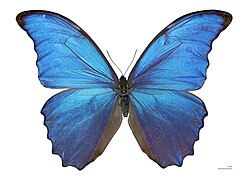This article includes a list of references, related reading, or external links, but its sources remain unclear because it lacks inline citations .(August 2016) |
| Morpho didius | |
|---|---|
 | |
| Dorsal view of male (MHNT) | |
 | |
| Ventral view of same specimen | |
| Scientific classification | |
| Domain: | Eukaryota |
| Kingdom: | Animalia |
| Phylum: | Arthropoda |
| Class: | Insecta |
| Order: | Lepidoptera |
| Family: | Nymphalidae |
| Genus: | Morpho |
| Species: | M. didius |
| Binomial name | |
| Morpho didius Hopffer, 1874 | |
| Synonyms | |
| |
Morpho didius, the metallic blue morpho, is a Neotropical butterfly belonging to the subfamily Morphinae of family Nymphalidae. It is considered, by some authors, to be a subspecies of Morpho menelaus .
